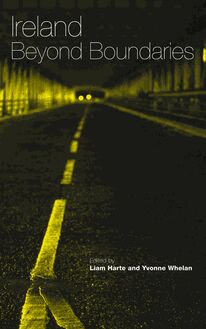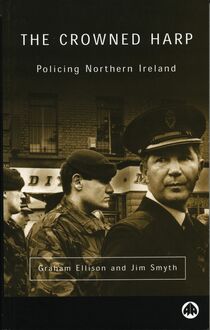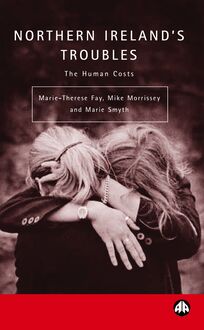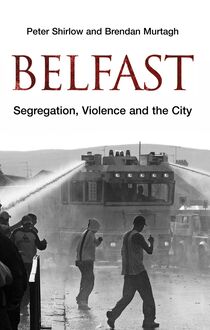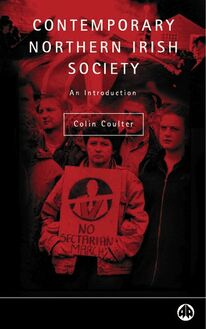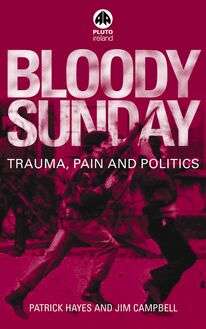-
 Univers
Univers
-
 Ebooks
Ebooks
-
 Livres audio
Livres audio
-
 Presse
Presse
-
 Podcasts
Podcasts
-
 BD
BD
-
 Documents
Documents
-
- Cours
- Révisions
- Ressources pédagogiques
- Sciences de l’éducation
- Manuels scolaires
- Langues
- Travaux de classe
- Annales de BEP
- Etudes supérieures
- Maternelle et primaire
- Fiches de lecture
- Orientation scolaire
- Méthodologie
- Corrigés de devoir
- Annales d’examens et concours
- Annales du bac
- Annales du brevet
- Rapports de stage
La lecture à portée de main
238 pages
English
Découvre YouScribe en t'inscrivant gratuitement
Je m'inscrisNorthern Ireland's Troubles , livre ebook
Découvre YouScribe en t'inscrivant gratuitement
Je m'inscris
Obtenez un accès à la bibliothèque pour le consulter en ligne
En savoir plus
En savoir plus
238 pages
English
Obtenez un accès à la bibliothèque pour le consulter en ligne
En savoir plus
En savoir plus

Description
This work provides a background to the Northern Ireland conflict. The authors investigate the human effect of the violence, looking at the geographical, religious, gender and age distribution of deaths due to the "troubles". They analyse the impact of the activities of the various armed participants, and examine the relationship between deprivation and levels of violence. Looking at suicide rates, levels of prescribed drug use, and mental health admissions, they examine the social impact of the conflict. They then compare this with the impact on the economy - GDP, unemployment levels, and public expenditure, putting forward a positive agenda for dealing with the effects of conflict, and for moving away from violence, towards peace.
Introduction
Part One CONTEXT
1 Northern Ireland, a state in conflict
2 Understanding Political Violence in Northern Ireland
3 Economic and Social Aspects of the Troubles
Appendix 1: Pen Pictures of the Protagonists
Appendix 2: A Chronology of Key Events
Part Two THE HUMAN COST OF THE TROUBLES
4 Profiling Those Who Died in Northern Ireland's Troubles
5 Patterns of Violence
6 Victims and Perpetrators
7 Half the Battle: the Impact of the Troubles on Children
8 Conclusions and Next Stops
References
Index
Introduction
Part One CONTEXT
1 Northern Ireland, a state in conflict
2 Understanding Political Violence in Northern Ireland
3 Economic and Social Aspects of the Troubles
Appendix 1: Pen Pictures of the Protagonists
Appendix 2: A Chronology of Key Events
Part Two THE HUMAN COST OF THE TROUBLES
4 Profiling Those Who Died in Northern Ireland's Troubles
5 Patterns of Violence
6 Victims and Perpetrators
7 Half the Battle: the Impact of the Troubles on Children
8 Conclusions and Next Stops
References
Index
Sujets
Informations
| Publié par | Pluto Press |
| Date de parution | 20 mars 1999 |
| Nombre de lectures | 0 |
| EAN13 | 9781849640275 |
| Langue | English |
| Poids de l'ouvrage | 1 Mo |
Informations légales : prix de location à la page 0,6250€. Cette information est donnée uniquement à titre indicatif conformément à la législation en vigueur.
Extrait
NORTHERN IRELAND’S TROUBLES The Human Costs
Marie-Therese Fay, Mike Morrissey and Marie Smyth
P Pluto Press LONDON • STERLING, VIRGINIA in association with The Cost of the Troubles Study
First published 1999 by Pluto Press 345 Archway Road, London N6 5AA and 22883 Quicksilver Drive, Sterling, VA 20166–2012, USA
Copyright © Marie-Therese Fay, Mike Morrissey and Marie Smyth 1999
The right of Marie-Therese Fay, Mike Morrissey and Marie Smyth to be identified as the authors of this work has been asserted by them in accordance with the Copyright, Designs and Patents Act 1988.
British Library Cataloguing in Publication Data A catalogue record for this book is available from the British Library
ISBN 0 7453 1379 5 hbk
Library of Congress Cataloging in Publication Data Fay, Marie-Therese, 1973– Northern Ireland’s troubles: the human costs/Marie-Therese Fay, Mike Morrissey, and Marie Smyth. p. cm. — (Contemporary Irish studies) Includes bibliographical references (p. ). ISBN 0–7453–1379–5 (hbk.) 1. Northern Ireland—History. 2. Political violence—Social aspects—Northern Ireland—History—20th century. 3. Political violence—Economic aspects—Northern Ireland—History—20th century. 4. Victims of terrorism—Northern Ireland—History—20th century. 5. Violent deaths—Northern Ireland—History—20th century. I. Morrissey, Michael, 1940– II. Smyth, Marie, 1953– III. Title. IV. Series. DA990.U46 F39 1999 941.6—dc21 98–45434 CIP
Designed and produced for Pluto Press by Chase Production Services, Chadlington, OX7 3LN Typeset from disk by Stanford DTP Services, Northampton Printed in the EC by TJ International, Padstow
Contents
List of Tables List of Figures Acknowledgementsix Introduction Map of Northern Ireland
CONTEXT
Outlines of Protagonists A Chronology of Key Events25
1 2 3
Northern Ireland, a State in Conflict Understanding Political Violence in Northern Ireland Economic and Social Aspects of the Troubles
THE HUMAN COST OF THE TROUBLES
4 Profiling Those who Died in Northern Ireland’s Troubles121 5 Patterns of Violence 6 Victims and Perpetrators 7 Half the Battle: The Impact of the Troubles on Children 8 Conclusions and Next Steps
Notes210 References212 Index
vi viii
1 7
9
11
51 73 95
119
133 156
180 201
221
List of Tables
1.1 Average Unemployment, 1922–29 1.2 Unemployment Rates, Great Britain and N. Ireland, 1931–39 1.3 Rates of Unemployment (Selected Regions) 1946–54 3.1 Religious Difference among Males in the Experience of Unemployment 3.2 Different Unemployment Rates between Religions, 1971–91 3.3 The Proportion of Households on Low Weekly ncomes, Selected Regions 3.4 Average Weekly Household Income by Religion 3.5 Employment in Externally Owned Manufacturing Plants in Northern Ireland 3.6 Average Weekly Household Incomes (£s), Selected Regions109 3.7 Industrial Output, the UK and NI, 1983–89 (1985 = 100) 3.8 Percentage Changes in Employees in Employment Northern Ireland and the UK, 1979–88 3.9 Employment Trends in Northern Ireland, 1981–91 3.10 Duration of Unemployment in Northern Ireland, 1981 and 1990 5.1 Distribution of Deaths (1969–98) 5.2 Distribution of Deaths by Month (1969–98) 5.3 Numbers and Death Rates with Northern Ireland District Council Areas 5.4 Deaths by Location in Postal Districts 5.5 The Number of Fatal Incidents and Resident Deaths in each Belfast Ward 5.6 A Comparison of Violence (1969–98) and Deprivation (1994) in Selected Districts 5.7 The Distribution of Resident Deaths in Five Localities148 5.8 A Comparison of Resident Deaths and Fatal Incidents in Selected Areas, 1969–98 5.9 Monthly Cycle of Resident Deaths, 1969–98 5.10 BT14 Residents Deaths by Perpetrator and Religion 5.11 Fatal Incidents in BT14 by Perpetrator and Religion
vi
55
56 57
96
97
104 105
107
111
111 112
114 137 139
142 143
144
146
149 150 153 153
LIST OF TABLES
vii
6.1 Deaths by Status, 1969–94 159 6.2 Injuries by Status, 1971–96 160 6.3 Gender of Victims161 6.4 The Age Distribution of Those Who Died 162 6.5 A Different Age Distribution 163 6.6 The Distribution of Deaths by Religion 164 6.7 Deaths Rates per 1000 between the Main Religions 164 6.8 Occupational Status of Victims 166 6.9 Affiliation of Victims167 6.10 Alternative Affiliation of Victims168 6.11 Organisations Responsible for Deaths 169 6.12 Deaths by Religion by Organisation Responsible 169 6.13 Political Status of Victims by Organisations Responsible for Deaths 170 6.14 Selected Age Groups by Organisations Responsible 171 6.15 Deaths by Gender in Selected Areas 172 6.16 Deaths by Religion in Selected Areas 173 6.17 Deaths by Political Status 174 6.18 Those Responsible for the Deaths in Selected Areas 175 6.19 Organisations Responsible for Deaths by the Political Status of Resident Victims 177 7.1 Deaths from 1969 to 1.3.1998 in the Northern Ireland Troubles by Age Grouping 181 7.2 Children and Young People Killed in the Troubles 1969 to 1.3.1998 by Age Grouping, Total Population in Age Group and Death Rate for Age Group 182 7.3 Death Rates at Each Age, 0–24, 1969 to 1.3.1998 183 7.4 Troubles-Related Deaths of Children and Young People under the ages of 25 and 18 by Postal Area in Northern Ireland and by other Locations: 1969–1.3.1998 184 7.5 Who Killed Those Under 25 and Under 18? (1969–1.3.1998) 187 7.6 Religious Affiliation of Those Under 25 and Those Under 18 Killed 1969–1.3.1998 189 7.7 Political Affiliation of Those Under 25 and Under 18 Killed 1969–1.3.1998 191 7.8 Cause of Death 1969–1.3.1998 192 7.9 Deaths from Plastic Bullets by Age of Victim at 13.11.1991 193 7.10 Casualties Under 20 as a Result of Paramilitary Punishments 194 7.11 All Casualties of Paramilitary Attacks 195 7.12 Age Breakdown of Punishment Shootings and Assaults 1991–97 196
List of Figures
5.1 6.1
Comparative Yearly Death Rates in the Troubles Deaths Rates for Age Groups per 1000 Population
viii
138 162
Acknowledgements
We wish to acknowledge the help of the following people: Dr John Yarnell, Department of Public Health, Queen’s University and the Health Promotion Agency; Dr Debbie Donnelly, NISRA; Wendy Hamilton, General Registry Office; Alison Hamilton, Central Services Agency; Ronnie McMillen, John Park, Social Services Inspectorate; Yvonne Murray, Linenhall Library; Andy White; Conor Barnes; Jonathan Blease; Alan Breen; Survivors of Trauma, Ardoyne; Greencastle Women’s Group; Damien Gorman, An Crann/The Tree; Tony McQuillan, Northern Ireland Housing Executive; Staff in the Central Library, Belfast, Queen’s University Library; David McKittrick; Professor John Darby; Dr Andrew Finlay, Trinity College Dublin; Dr Maggie Martin, Eastern Connecticut State University; Brandon Hamber, Centre for the Study of Violence and Reconciliation, Cape Town; Patrick Ball of the American Association for the Advancement of Science in Washington, DC for providing some of the international data; The Community Information Technology Unit, Belfast; The Centre for Childcare Research at the Queen’s University of Belfast; Dr R. Scullion of the Central Statistics Unit; Arlene Healey from the Young People’s Centre; John Park from the Social Services Inspectorate of the Department of Health and Social Services; Dr Brian Tipping, Research Services Ireland; young people from various communities in North and West Belfast, Derry and elsewhere contributed enormously to our understanding of their position; over sixty adult interviewees participated in our enquiries, and many gave us much by way of understanding of parental roles, and their experience. Dr Roger McGinty at INCORE provided feedback on a draft of the book. Our colleagues, Gwen Ford, Sarah Oakes and Mark Mulligan at The Cost of the Troubles Study, and fellow directors of The Cost of the Troubles Study, particularly David Clements, Brendan Bradley, John Millar, Hazel McCready, Sam Malcolmson, Linda Roddy, Mary Donaghy and Shelley Prue have provided assistance, guidance and feedback. Tracy Wong of the Urban Institute assisted with the statistical analysis. Others who offered feedback were Paul Morrissey, Mary Enright, Bel McGuinness, Marguerite Egin, and Dr Yallowly from the
ix
x
NORTHERN IRELAND’S TROUBLES
Department of Public Health at the Queen’s University of Belfast, who also provided useful suggestions about other research. We thank those who funded the research on which this book is based: the Central Community Relations Unit of the Central Secretariat; Making Belfast Work, North and West teams; the Special Support Programme for Peace and Reconciliation through the Northern Ireland Voluntary Trust; the Joseph Rowntree Charitable Trust; a private donation; Barnardo’s Northern Ireland, Save the Children Fund; the Cultural Diversity Group of the Community Relations Council, the Belfast European Partnership Board and the Community Relations Council. Finally, we thank Roger van Zwanenberg and everyone at Pluto Press.
Introduction
The purpose of this book is to describe the human costs of Northern Ireland’s Troubles, and to set those human costs in the historical, political, economic and social context of Northern Ireland. The book is organised in two main parts. The first part of the book provides a detailed context, both local and international, for the conflict and its human costs that are analysed in the second part. In this analysis, the demography of deaths in the conflict are discussed, and the geographical distribution of deaths and their relationship to other factors such as deprivation examined. Deaths are also analysed by perpetrating organisation and by the affiliations and other charac-teristics of those killed. Finally, Chapter 7 examines data on the impact of the Troubles on children and young people, and the conclusions look to the future of Northern Ireland in the light of the human costs incurred over the last 30 years. The book is written in an atmosphere unprecedented in Northern Ireland. The cease-fires of 1994 ushered in a new sense of energy, possibility and determination for many people involved in under-standing, participating or intervening in the Northern Ireland conflict. The declared end of violence on the part of both Loyalist and Republican paramilitaries removed a pressure to which we had become habituated in order to live with the relentless violence of the Troubles since the 1960s. Yet in that new atmosphere, it became painfully clear how those cease-fires had come too late for many. The suffering of those who had lost family members, homes, parts of their bodies, peace of mind or the ability to sleep through the night, could begin to be explored. Until then, it was as if we dared not realise the extent of the damage in case we had to live with more of it. A mother of five children in Beirut, cited by Raija-Leena Punamaki (1988: p. 4), said:
Let’s talk about psychology when the war is over. When the war is over, I will dream all those dreams I cannot afford to now… If I were to sit down and think of my emotional state, I would break down. You Europeans, you can have the luxury of analysing your feelings; we plainly have to endure.
1
2
NORTHERN IRELAND’S TROUBLES
For the first time in our adult lives in Northern Ireland, after the 1994 cease-fires, it seemed possible to turn our attention to exploring the issue of loss, and the suffering that many people had endured. An earlier study (Smyth and Hayes, 1994) shocked the researchers into the realisation that the depth and scale of suffering might well be greater than anyone imagined. Yet at the time the study was conducted, the violence was continuing. Under such conditions, the conduct of such research was very challenging, and the discourse about suffering and loss was highly polarised – and remains so. The suffering of one group may be dismissed and disqualified by referring to the suffering of another group on the ‘other side’, or to wrongs that have been done by the faction associated with those who had suffered. In that pre-cease-fire atmosphere – and indeed subsequently – there can be competition between groups and individuals for the position of ‘those who had suffered most’. Implicit in this competition is the assumption that those who have lost the most, or had the largest number killed cannot be held morally culpable for any damage done by their side, since any wrongs can be seen as understandable retaliation. Such is the inhuman dynamic of armed conflict. Repeatedly, those who have been bereaved have called for no retaliation. However, the voices of those who have lost most do not carry sufficient authority, and often go unheeded. Those who have been bereaved and injured, as we demonstrate in this book, are pre-dominantly civilians, unconnected with paramilitary groups or security forces. They have often been randomly targeted. The loss and injuries inflicted are ‘nothing personal’ – it could happen to anyone. Therefore, the bereaved and injured have no basis on which they may influence the political process. They have no political clout, they do not have the capacity to wreck the prospects for peace, nor do they have the power to command the ears of politicians. They are not a coherent group of people, they do not agree among themselves, they have been hurt by various people – Republican, Loyalist and security forces. They do not all want or feel comfortable with the same things, or with each other. It was in that atmosphere, and with these concerns that a group of people with direct personal experience of loss in the troubles were invited by one of the researchers to meet in Belfast in order to explore some of these issues. The group that began to meet were diverse – people bereaved by Republicans, Loyalists, the security forces; disabled police officers. It was out of these meetings that The Cost of the Troubles Study – a Belfast-based recognised charity that
-
 Univers
Univers
-
 Ebooks
Ebooks
-
 Livres audio
Livres audio
-
 Presse
Presse
-
 Podcasts
Podcasts
-
 BD
BD
-
 Documents
Documents
-
Jeunesse
-
Littérature
-
Ressources professionnelles
-
Santé et bien-être
-
Savoirs
-
Education
-
Loisirs et hobbies
-
Art, musique et cinéma
-
Actualité et débat de société
-
Jeunesse
-
Littérature
-
Ressources professionnelles
-
Santé et bien-être
-
Savoirs
-
Education
-
Loisirs et hobbies
-
Art, musique et cinéma
-
Actualité et débat de société
-
Actualités
-
Lifestyle
-
Presse jeunesse
-
Presse professionnelle
-
Pratique
-
Presse sportive
-
Presse internationale
-
Culture & Médias
-
Action et Aventures
-
Science-fiction et Fantasy
-
Société
-
Jeunesse
-
Littérature
-
Ressources professionnelles
-
Santé et bien-être
-
Savoirs
-
Education
-
Loisirs et hobbies
-
Art, musique et cinéma
-
Actualité et débat de société
- Cours
- Révisions
- Ressources pédagogiques
- Sciences de l’éducation
- Manuels scolaires
- Langues
- Travaux de classe
- Annales de BEP
- Etudes supérieures
- Maternelle et primaire
- Fiches de lecture
- Orientation scolaire
- Méthodologie
- Corrigés de devoir
- Annales d’examens et concours
- Annales du bac
- Annales du brevet
- Rapports de stage
Signaler un problème
YouScribe
Le catalogue
Le service
© 2010-2024 YouScribe
